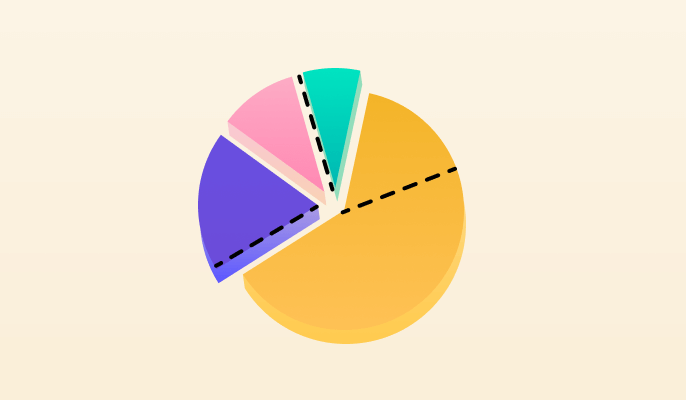Many self-employed people worry about their pension. Some people even see it as a barrier to starting a business in the first place. In reality, the idea that self-employed people will only have a small pension isn’t necessarily true. It’s possible to significantly increase your pension by making smart choices and through tax optimisation.
In this guide, we answer your most pressing questions: How do pensions for the self-employed work in Belgium? What is the statutory pension amount? How do I calculate my pension as a self-employed person and how can I supplement it?
Your statutory pension as a self-employed person
Just like employees and civil servants, the self-employed are entitled to a statutory pension. This is financed by the social security contributions you pay throughout your career.
Thanks to government reforms and the implementation of the Voluntary Supplementary Pension Scheme for the Self-employed (VSPSS, or PLCI in French and VAPZ in Dutch) and the Individual Pension Commitment (IPC, or EIP in French and IPT in Dutch) (see below), pensions for the self-employed have increased in recent years.
Calculation of the statutory pension
Your statutory pension is calculated based on:
- your professional income on which you paid social security contributions
- the number of years you were self-employed
- the legal pension age (currently 66, but 67 from 2030)
A full career is defined as 45 years. The longer you pay social security contributions, the higher your pension will be. For a full, 45-year career, you’re entitled to a full pension.
Your quarterly pension is calculated as follows: your taxable income x 0.25 (i.e. for a quarter) x the number of days worked. The final pension is 60% of this amount if you are single or 75% if you receive a ‘household pension’.
The minimum pension for the self-employed
Has your income decreased during your self-employed career? You may be entitled to the minimum pension.
The minimum pension for self-employed people with a full career of 45 years is:
- €20,437.44 per year for a single person
- €25,538.78 for a household pension
Note: You must have had a career of at least 30 years to receive the minimum pension. This is calculated pro rata based on a 45-year career.
How to supplement your pension when you’re self-employed?
The statutory pension for the self-employed is often insufficient. That’s why there are various ways to supplement it.
Voluntary Supplementary Pension for the Self-employed (PLCI/VAPZ)
The Pension Libre Complémentaire pour Indépendants (PLCI)/Vrij Aanvullend Pensioen voor Zelfstandigen (VAPZ) is a tax-efficient way to supplement your pension. Here are the benefits of the PLCI/VAPZ:
- You choose the amount to invest, with a maximum of 8.17% of your taxable income and a maximum of €4,000.44 (in 2025).
- The premiums are 100% deductible as business expenses, which means you pay less in tax.
- As a result, your social security contributions are also lower.
- You also benefit from a tax advantage at retirement age.
A win-win situation, therefore, since you save for your future while optimising your taxes and social security contributions.
Pension Agreement for the Self-Employed (CPTI/POZ)
Any self-employed sole trader can take out a Convention de Pension pour Travailleurs Indépendants (CPTI)/ Pensioenovereenkomst voor Zelfstandigen (POZ) to supplement their pension. Here are the advantages of the CPTI/POZ:
- This is an attractive option for saving for the future, given that the PLCI/VAPZ and individual pension savings are capped.
- You’re entitled to a 30% tax reduction on your premiums if your total pension does not exceed 80% of your gross annual income.
- You decide how much to invest.
- You can get a higher return than with a PLCI/VAPZ.
Individual Pension Commitment (EIP/IPT)
People who are self-employed with a company can take out an Engagement Individuel de Pension (EIP)/ Individuele Pensioentoezegging (IPT). These pension contributions are financed by your company and are deductible as professional expenses.
Other ways to supplement your pension when you’re self-employed
As a self-employed person, you can also choose to supplement your pension in the following ways:
- Investing in real estate by purchasing an office, workspace, or home. Mortgage interest on the part of your home you use for your self-employed activity may be tax deductible.
- Investing in stocks, ETFs, or cryptocurrencies to achieve a potentially higher return.
Pension when you’re self-employed in a main vs secondary occupation
When you’re self-employed in a main occupation, you build up your pension as described above. But what if you’re self-employed in a secondary occupation? Your pension then depends on your main activity as an employee or civil servant.
Note: If you’re self-employed in a secondary occupation, you can build up a supplementary pension provided you pay at least €750 in social security contributions. This is the condition for setting up a PLCI/VAPZ or a CPTI/POZ.
FAQ about pensions for the self-employed
The pension for someone who has been self-employed depends on several factors. The average pension ranges between €1,200 and €1,500. It can be higher if you invest in solutions such as a PLCI/VAPZ or a CPTI/POZ.
You can easily simulate your pension by logging in to mypension.be using Itsme. There, you’ll get an estimate of your statutory and supplementary pension. Want to calculate it even faster? Use our pension simulator!
You can supplement your pension by subscribing to a PLCI/VAPZ or a CPTI/POZ, by investing in real estate or shares, or by using an EIP/IPT if you have a company.
If you have had a full career of 45 years, you’re entitled to a minimum pension. If you’ve worked less than 45 years, the minimum pension will be calculated pro rata.
